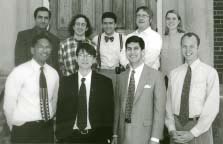
| T H E N I H C A T A L Y S T | J U L Y - A U G U S T 1 9 9 8 |
NIH
GRADUATE
SCHOOL
|
by Paul Torrence, Ph.D., Director, and Chief, Biomedical Chemistry Section, NIDDK Laboratory of Medicinal Chemistry |
In academic circles, the season of rebirth is the fall. The metaphor is especially true at the NIH campus this fall, where two new departments, 32 new courses, and an additional 20 instructors from the NIH fellows community promise to make the 1998—1999 academic year at the NIH Graduate School one of the most exciting in its 39-year history.
Shortly after my appointment earlier this year as director of the graduate school, which is run by the Foundation for Advanced Education in the Sciences (FAES), I put out a call for new course ideas and new instructors; the heartening and enthusiastic response I got from the NIH community has enabled us to revise and expand the curriculum to meet the directive of FAES president Ed Rall that the course offerings reflect the "revolutions occurring in biology" today.
The 184 courses that constitute the new curriculum encompass areas of current interest, new approaches and methodologies, cutting-edge basic and clinical research, introductory basic science courses, an MCAT review, and even a speed-reading class.
Among the new courses that capture contemporary currents are:
• An introduction to AIDS and HIV research that reviews the virology, biochemistry, and immunological aspects of the disease, vaccine and drug treatment and development, and design and implementation of methods to prevent HIV spread (Carl Dieffenbach, NIAID, coordinator).
• "Emerging Diseases" (spring; Catherine Laughlin, NIAID, instructor).
• "Nature’s Treasures: Exploring Natural Products Chemistry and Drug Development," highlighting the premier natural products work here at NIH (Lewis Pannell, NIDDK, coordinator).
• "Biodiversity" (spring; Jamie Reaser, Smithsonian Institution, instructor).
But these are just the icing on the cake. The depth of expertise we have available around us has permitted the school to offer other new courses as well, including:
• "Neural-immune Interactions" (Esther Sternberg, NIMH).
• "Cytokines in the Immune, Inflammatory, and Hematopoietic Systems" (Scott Durum, NCI, and Joshua Farber, NIAID);
• "Calcium Signaling in Cells" (James T. Russell, NICHD).
• "The Structure and Function of the Nucleus" (Mary Dasso, NICHD).
• "Developmental Neurobiology" (Christine Brennan, NINDS).
• "Genetics in Complex Disease Research (Darrell Ellsworth, NHLBI).
• "Mitochondrial Genetics and Biogenesis (Steve Zullo, NIMH).
• "Survival Data Analysis and Categorical Data Analysis" (Timothy Chen, NCI).
• "Therapeutic Oligonucleotides and Antisense" (Y. S. Cho-Chung, NCI, and Serge Beaucage, CBER).
• "Clinical Significance of Molecular Markers of Carcinogenesis, Growth, and Differentiation (Nicholas J. Sarlis, NIDDK).
• Two neurophysiology courses that cover an introduction to the science and then move to pathologies such as Alzheimer’s and Parkinson’s (Wolfram Gottschalk, NINDS).
• Current topics in molecular genetics (Clair Francomano, NHGRI, and Robert Nussbaum, NHGRI).

|
|
|
This year, the FAES Graduate School will assist with CC director John Gallin’s now-indispensable "Core Course in Clinical Research," which will be offered through the school as "Introduction to the Principles and Practice of Clinical Research."
To support NIH’s growing interest in the imaging sciences, the FAES Graduate School has added a new Department of Imaging Sciences, headed by Nick Bryan (CC) and Robert Balaban (NHLBI). The fledgling department will offer three new courses in 1998—1999–"Magnetic Resonance Imaging" (Jeff Duyn, CC), "Positron Emission Tomography" (Peter Herscovitch, CC), and "Fundamentals of Light Microscopy and Electronic Imaging" (Kenneth Spring, NHLBI ).
Calvin Johnson of NIH’s Center for Information Technology (CIT) is chairing a new Department of Computer Sciences, which will collaborate with the computer center to offer courses in 1998—1999 in "Fundamentals of Numerical Optimization," "Numerical Methods and Computation," "Artificial Neural Networks," and "Design and Analysis of Algorithms."
In another collaborative venture with the CIT computer center, Robert Phair, president of BioInformatics, a consulting firm in Rockville, will teach an intensive, hands-on course in "Integrative Bioinformatics." Each student will build and test a computer model of the molecular or cellular system that he or she finds of greatest interest. The result will be a quantitative statement of a working hypothesis that can be tested against experimental data.
The basics have not been left behind, either. The introductory Biochemistry 300 course has been reinstituted and restaffed, as has Biochem 433, "Current Methodology on Nucleic Acids Structure and Function." And we are delighted to be able to continue offering "BIOTRAC" courses, now numbering 19 and including new offerings on mutation detection and analysis and the cell cycle, as well as familiar courses such as cell culture. Investigators considering venturing into new fields and the pre-IRTA community should find these courses invaluable.
For a catalog for the 1998—1999 academic year, call the FAES Graduate School at (301) 496-7976; it’s also available by mail: FAES, One Cloister Court, Bethesda, MD 20814-1460; interoffice: Building 60, Suite 230; or through the FAES Graduate School Web page: <http://faes.org/gradsch.htm>.
Registration deadline for the fall semester is August 31, by mail. Walk-in registration at FAES (Building 60) is September 1—8. Classes begin September 14. We urge everyone to register by September 8, because classes that do not meet enrollment quotas will be cancelled after that date.
Anyone interested in joining the faculty and offering a course should contact me at (301) 496-2653; e-mail: <torrence@helix.nih.gov>.
|
DUKE-NIH
PROGRAM OFFERS
NIH TRAINEES
|
|
PRAT PROGRAMS: NOW THERE ARE TWONIH is launching a new specialty program to recruit and train PRAT fellows in Clinical Pharmacology. The new program, organized by Arthur Atkinson of the Clinical Center, is designed to create a cadre of scientists with much-needed expertise in the clinical development, evaluation, and therapeutic use of small molecule- and biotechnology-based pharmacotherapy. The Clinical Pharmacology PRAT Fellows will devote most of their time to clinical and lab research, but will also receive didactic training in clinical research, principles of clinical pharmacology, and biostatistics. Each fellow will have a research preceptor; preceptor and applicant selection is by steering committee. Candidates must be U.S. citizens or permanent residents and should have an M.D. degree with three years of residency training and board eligibility in a primary medical specialty. A good mathematics background is important. Applications are due in October; the program begins in July. Appointments are for two years, with a third year possible if warranted by the trainee’s research. For more information, contact Arthur Atkinson [(301) 435-8791] or see the clinical pharmacology Web site: <http://www.cc.nih.gov/OD/clinprat/>. The regular PRAT program continues to support fellows in other areas of pharmacological sciences. Applications are next due January 5, 1999. Individuals may now apply not only before coming to NIH or the FDA’s CBER but also after, provided they began their postdoctoral work here within the 12 months preceding PRAT’s application deadline. Applicants must be U.S. citizens or permanent residents and have received their doctorate or professional degree in basic or clinical science within the five years prior to applying. The Web site for the overall PRAT program is: |
CLINICAL RESEARCH
TRAINEES GO
OUT IN STYLE
 |
|
First Class: The first graduates of the Clinical Research Training Program (CRTP), sponsored by NIH and the National Foundation for Biomedical Research, posed for a group shot outside the Cloister, where they delivered their end-of-the-year scientific presentations on subjects ranging from "Pallister-Hall Syndrome: Combining Psychiatry and Genetics" to "Interferon Gamma Receptor Deficiency: Construction of a Retrovirus for Gene Therapy" and "Cytotoxic Activity of Anti-Tac(Fv)-PE38 toward Lymphocytes from Patients with Hairy Cell Leukemia." The nine were selected from a field of 78 applicants–all students who have completed their third year of medical or dental school. The program has expanded to 17 for the coming round: 15 new trainees and two students who are extending their CRTP stay into the optional second year. [Back row, left to right: Eric Eskioglu, University of Kansas (Kansas City); Uri Lopatin, University of Medicine and Dentistry of New Jersey-Newark; Amin Azzam, Medical College of Virginia (Richmond); Cliff Davis (UCLA); Jill Anderson, University of Nebraska (Omaha); front row, left to right: Eric Brown, UCLA; Arthur Li, UCSF; Jonathan Samuels, Cornell University Medical School (New York); David Robbins, Mount Sinai School of Medicine (New York)]